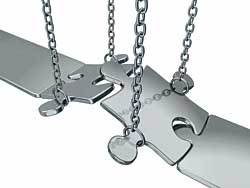Providing a Chain's Links
International supply chain can be protected by providing close partnerships
- By Rob Schorr
- Sep 01, 2006
 BILLIONS of goods flow through worldwide ports, but can the Customs-Trade Partnership Against Terrorism (C-TPAT) protect international maritime trade? This voluntary (for the time being), government-business initiative can provide the necessary cargo security through close partnerships with those involved in the international supply chain. Importers, carriers, consolidators, licensed custom brokers and manufacturers all have to adopt policies that will safeguard the international maritime shipping industry.
BILLIONS of goods flow through worldwide ports, but can the Customs-Trade Partnership Against Terrorism (C-TPAT) protect international maritime trade? This voluntary (for the time being), government-business initiative can provide the necessary cargo security through close partnerships with those involved in the international supply chain. Importers, carriers, consolidators, licensed custom brokers and manufacturers all have to adopt policies that will safeguard the international maritime shipping industry.
Importers, carriers, consolidators, licensed custom brokers and manufacturers all have to adopt policies that will safeguard the international maritime shipping industry.
With the increasing threat of terrorism, C-TPAT relies on the complete cooperation of the entire global supply chain. Most consumers take for granted the security needed to safely move goods from a manufacturer to a retail outlet.
Take a typical sweater purchased in a local department store as an example of the security cooperation needed in today's maritime economic infrastructure. According to one Unisys case study released this spring, shipping that sweater from the producer to the customer involved 14 handoffs in five different countries.
A Long Journey
From a Karachi, Pakistan, manufacturing facility, the garment was shipped by truck to ports in India and Sri Lanka. Then, after nearly 20 days at sea, traveling through the Indian Ocean, the Mediterranean Sea and then the Atlantic Ocean, the sweater arrives in Nova Scotia, Canada, where it's loaded on another ship for delivery to the United States. Arriving in New York, the sweater is then shipped to Chicago, where a distribution center then assigns that sweater for delivery via freight truck to a department store in Peoria, Ill. It's in this scenario that the C-TPAT initiative is dependent on mutual cooperation between five diverse nations and hundreds of handlers to ship one sweater that someone gave to their father for his birthday.
The C-TPAT agreement is intended to prevent a major security incident, which assures the maritime industry will experience only smooth sailing in its ports. The members of the alliance understand how one, supply-based attack can seriously impact the world's marketplace, not to mention the livelihood of every worker involved in every shipping transaction. That's why it's important for the maritime shipping industry to consider some significant changes to security programs.
Paramount to these considerations is for the shipping industry to build a unified, data aggregation platform that allows C-TPAT-qualified firms to exchange information through a common communication structure. The alliance also must establish uniform processes, dealing with the establishment of a trusted driver (or agent) program, cargo registration and the joint tracking, including shipment handoffs and routine delivery times that will interface within the platform.
The unified platform has to work within the existing infrastructure of surveillance cameras and wiring already monitoring the movement of shipped goods. As part of the C-TPAT agreement, the firms involved in the shipment of goods need to agree upon a standard that can help easily communicate security information among its members. For example, the Port of Houston has more than 170 businesses and government organizations, each with different security systems reporting to the Coast Guard and several other disjointed federal and state agencies that all monitor shipping in the Texas bay area. If there's that kind of disparity in one port, imagine the differences in an international shipping chain. A unified platform that brings together security cameras, biometric devices and access control with a uniform look and security protocols can help maritime partners communicate in real time if there are developing issues involving security.
As security needs evolve, the maritime shipping industry also will need to agree to enhance the capabilities of their container security, tracking, associated digital video surveillance and wireless communications infrastructure to facilitate this unification. Of special note is the need to screen or detect chemical, biological, nuclear, radiation and explosive shipments. Joseph McGrath, CEO of Unisys, said in a May speech at the World Congress on Information Technology, that he estimates that ports could only detect 10 percent of these devices with current detection systems.
Embracing Biometrics
C-TPAT companies need to embrace not only a standardized access control that can identify the maritime professional and their general security access, but biometric scanners, as well.
Access control cards are easy to copy or give to someone who looks like someone else. A biometric device that registers either a person's finger or an eye can truly verify the identity of each transportation professional.
At least one manufacturer is already pursuing an identical standards-based initiative for each select foreign port, as well as a U.S.-based C-TPAT effort in the hopes of accelerating the voluntary program and implementing a unified communications standard prior to it becoming a universal mandate. Some in the maritime industry can't ignore the costs to update and add new security platforms, especially when faced with the domestic growth of shipping needs. The economic impact of the shipping industry this year on the American economy ranges in the $9.8 trillion range. Analysts project this cost to triple within 40 years, not only for United States but foreign shipping, as well.
Anything that threatens the maritime industry can cause major implications. One attack on a port or in the supply chain can impact everything from the cost of a morning cup of coffee to the clothes worn to work. A unified command and control platform will help mitigate the likelihood of such an attack on the economy.
This article originally appeared in the September 2006 issue of Security Products, pgs. 32-34.